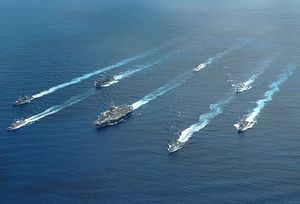Last week, James Holmes described the ongoing difficulties involved with establishing forward U.S. bases in the Philippines. Despite the evident threat that the PLAN poses to Philippine territory in the South China Sea, the process of balancing has moved slowly, largely because of domestic concerns in Manila about a military U.S. presence.
The lesson Dr. Holmes describes is that international threat, especially at incipient levels, does not automatically transform into the sort of domestic flexibility that offshore balancing demands. Friction, whether generated by organizational dynamics, concerns about sovereignty, or historical grievance, can slow the balancing machinery. It’s difficult to solve the problem of friction in alliance politics, especially if key procedures haven’t been worked out in advance. Yet, eliminating friction requires building relationships over the long term, usually involving the kind of commitments (at least implicit) that Offshore Balancers tend to resist.
To outline briefly, offshore balancing eschews direct alliance commitments in order to prevent free-riding and entanglement in conflicts of no great interest. An offshore balancer cares about the rising power of China, not the status of a few rocks in the South China Sea, except insofar as the latter contribute to the former.
But in the modern military context, the projection of U.S. power requires pre-commitments; bases need to be ready to accept U.S. aircraft, technicians, and associated support personnel, even if the units themselves can deploy in short order. Especially in a crisis situation, the mechanisms that are supposed to provide for effective balancing opportunities may not manifest quickly enough.
Fortunately for U.S. strategic interests (if not the victims of the storm), the U.S. Navy’s support in the aftermath of Typhoon Haiyan may win sufficient goodwill to overcome local opposition to a renewed U.S. military role. However, if shoring up relationships requires a consistent diet of such interventions, offshore balancing loses some of its appeal. If , in practical terms, offshore balancing demands roughly the same capabilities as forward primacy, then it seems to offer little real advantage. It’s also worth noting that if missions such as disaster relief provide the lubricant for offshore balancing, China can render the U.S. position more vulnerable by more competent, enthusiastic efforts on its own part.
Consequently, it may make more sense to work out a middle path between forward “deep engagement” and offshore balancing. Offshore engagement retains forward operating capability and emphasizes beneficial multilateralism, both to its own ends and in support of broader strategic interests. However, it remains essentially defensive, oriented around preventing the regional dominance of peer competitors rather than primacy in the management of global political affairs. Like offshore balancing, it attempts to take advantage of quasi-natural balancing behavior by threatened local partners, but it also appreciates that partnerships require work, and don’t develop overnight.

































